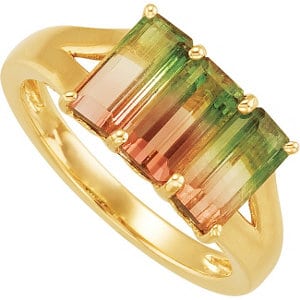No problem! An October birthstone, can help — the OPAL, where you can see all the colors of the rainbow.
Opal is often considered to be the most beautiful and desirable of all gems. No other gemstone can display all the colors of the spectrum in such an infinite variety of shades, patterns and brilliance.
No two are identical– and for this reason, the proud owner of an opal can delight in the fact that their gem is truly unique.
“A similar phenomena of color hues can be seen when oil lies on water, or the play of light giving rise to a rainbow.”
Opal’s internal structure makes it diffract light; depending on the conditions in which it formed it can take on many colors. Opal ranges from clear through white, gray, red, orange, yellow, green, blue, magenta, rose, pink, slate, olive, brown, and black. Of these hues, the reds against black are the most rare, and white and greens are the most common.
“Ninety-five percent of the world’s precious opals comes from Australia, where special geological conditions and climate coincide for the formation of this rare gemstone.”
Legend
The complex and colorful opal ensures fidelity and confidence for people born in October, in addition to sharpening the mind and emotions.
“To ancient Romans, the opal was a symbol of love and hope.”
The opal was regarded as a means to clairvoyance, one far more effective than the traditional crystal ball.
According to legend, the wearer of an opal will be polite and courteous and protected from the wrath of others. The stone was also known to make its owner invisible to foes and thereby exempt from misfortune. Opals were supposed to drive away despondency and evil thoughts, cure kidney diseases and cholera, soothe the eyes and nerves and protect against lightning. It was believed to make wishes come true and was particularly favorable to children, the theater, amusements, friendships and emotions. It is the gem of inspiration in the arts and in love.
Tips on Looking After your Opal
Although Opals are a magnificent and unique gem, they do not have the same resistance to breaking or scratching as diamonds or sapphires. If you protect your stone from heavy blows, abrasive materials, and don’t subject it to extreme sudden heat changes, your opal should last forever.
Tourmaline
The alternate birthstone for October is the Tourmaline, a gemstone that that also exhibits a broad spectrum of gemstone colors.
Everyone loves Tourmaline! It has become a favorite gemstone, especially among jewelry designers and gem collectors all over the world. Since it is available in a wide variety of colors, it is ideally suited to almost anyone’s taste.
Tourmaline also is known for displaying several colors in the same gemstone. These bi-color or tri-color gems are formed in many combinations; gemstones with clear color distinctions are highly prized. One multi-color variety is known as watermelon tourmaline, and features green, pink, and white colors bands;and to resemble its namesake, the gemstone is cut into thin slices having a pink center, white ring, and green edge.
Tourmaline is found all around the world, but Brazil is the most important source of tourmaline, but recently California has become a significant producer. Other sources include Madagascar, Maine, Sri Lanka, Burma and Russia.
 Gem-quality forms of this mineral have in the past been misidentified as rubies, emeralds and sapphires. In fact, a famous tourmaline-the size of a pigeon’s egg-belonging to the Russian Empress Catherine the Great was thought to be a ruby.
Gem-quality forms of this mineral have in the past been misidentified as rubies, emeralds and sapphires. In fact, a famous tourmaline-the size of a pigeon’s egg-belonging to the Russian Empress Catherine the Great was thought to be a ruby.
The name of this gemstone is believed to derive from the Singhalese (Sri Lankan) word “toramalli,” a term applied to yellow, green or brown stones, that means “something little out of the earth.”
The most valuable variety of tourmaline is red to purplish-red to violet-red. it comes in an infinite variety of hues and tones. Most common are green and light red tourmalines, but others are dual-colored stones in blue, yellow and pink, brown and black.
Tourmaline may be cut into any style, including step, brilliant, mixed and cabochon. It is often carved into flowers, leaves and similar forms and set in jewelry with diamonds and other colored stones.
Tourmaline has an unusual property. When it is warmed or rubbed, it attracts small bits of paper, lint and ash. This occurs because the gem becomes charged with static electricity. In fact, Benjamin Franklin used this gem in his studies of electricity.
Maintaining a tourmaline exhibit at museums requires frequent cleaning of the gemstone because heat from lights of the display case create a charge in the stone that attracts dust.
Compared with other gemstones, tourmalines are a relatively recent discovery. So it lacks the rich lore that accompanies many other precious gems. However, to some people, the stone is known as the “peace stone,” believed to dispel fear and make its wearer calm.









